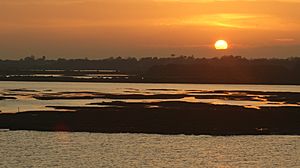Hurst Castle and Lymington River Estuary facts for kids
| Site of Special Scientific Interest | |
 |
|
| Area of Search | Hampshire |
|---|---|
| Interest | Biological Geological |
| Area | 1,077.3 hectares (2,662 acres) |
| Notification | 1986 |
| Location map | Magic Map |
Hurst Castle and Lymington River Estuary is a very special place in Hampshire, England. It covers a huge area of about 1,077 hectares (that's over 2,600 acres!). This area is important for both its amazing wildlife and its unique geology (how the land is formed). It's officially called a Site of Special Scientific Interest (SSSI) because of its rare plants, animals, and land features.
This SSSI is part of several important nature areas. These include a Nature Conservation Review site and two Geological Conservation Review sites. Some parts are also Local Nature Reserves, like Boldre Foreshore, Sturt Pond, and Lymington and Keyhaven Marshes. The Hampshire and Isle of Wight Wildlife Trust helps manage the Lymington and Keyhaven Marshes. It's also part of the North Solent National Nature Reserve. Plus, it's recognized internationally as a Ramsar site and a Special Protection Area for birds.
Contents
What Makes This Place Special?
This SSSI stretches for about 9 kilometers (5.6 miles) along the coast of The Solent. It has many different types of coastal habitats. These habitats are quite rare along the south coast of England. They are important for both their living things (biology) and how the land is shaped (geomorphology).
On the side facing the sea, you'll find three river mouths. These areas have wide, flat mudflats that appear at low tide. There are also marshes covered in a special grass called Spartina anglica, and higher saltmarshes. Inland from the sea wall, there are freshwater and brackish (slightly salty) marshes. These surround several lagoons. The water in these lagoons can be fresh or brackish. They are home to rare invertebrates (animals without backbones) and plants.
A long, narrow strip of shingle (small, rounded stones) called Hurst Spit forms one edge of the site. This spit is very important for understanding geology. It helped scientists explain how beaches are shaped by waves.
Amazing Invertebrates
Hurst Castle and Lymington River Estuary is one of only five places in the United Kingdom where the starlet sea anemone (Nematostella vectensis) lives. This tiny creature is listed as Vulnerable by the IUCN. Outside the UK, it's only found in a few spots in eastern North America.
This site is also the only known place in Britain to find the polychaete worm Armandia cirrhosa. Another unique resident is the amphipod Gammarus insensibilis. Both of these creatures are found at their most northerly known locations in the lagoons behind the sea wall here.
Birds of the Estuary
The mudflats here are a fantastic feeding ground for many different birds. In winter, large groups of brent geese, Eurasian wigeon, and Northern pintail ducks use the estuary. Wading birds like dunlin, black-tailed godwit, and grey plover search for food in the mud. They then rest in the marshes and on the shingle ridges.
Sandwich and little terns build their nests on the shingle ridges. They share these nesting spots with black-headed gulls. These fish-eating birds, along with great cormorants, hunt for their prey in the rich waters of the area. Birds of prey, such as Western marsh harriers, peregrine falcons, and merlins, are also drawn to the area. They come to hunt the large flocks of wildfowl and wading birds.
A Look Back in Time
Long ago, these marshes were used to produce salt. People would collect seawater and let it evaporate to get salt. However, this practice stopped in the 1800s. After that, the land slowly returned to its natural state as saltmarsh.

